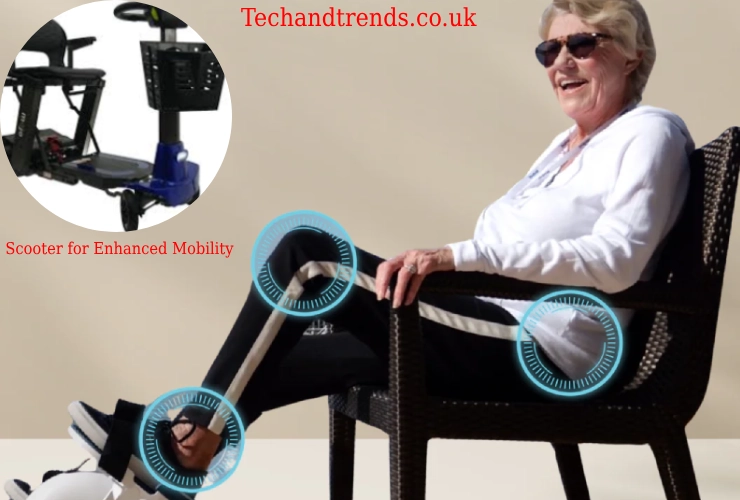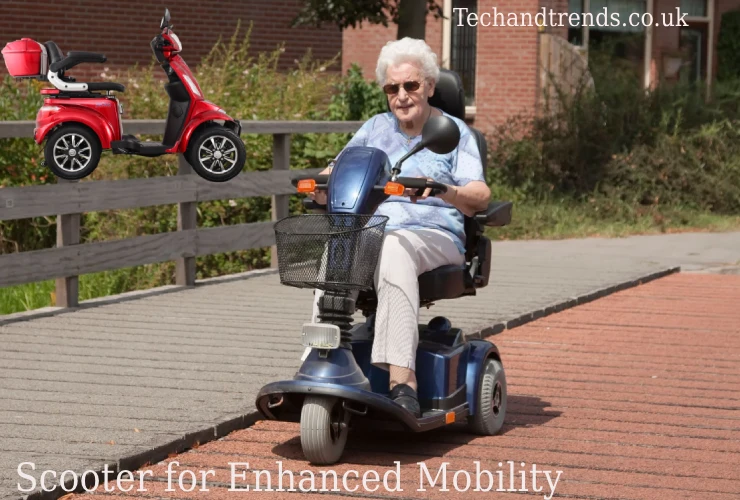Scooter for Enhanced Mobility: In an age where urbanization and environmental concerns dominate societal discussions, the demand for enhanced mobility solutions is critical. Scooter for Enhanced Mobility has emerged as a popular choice for individuals seeking efficient, eco-friendly, and accessible means of travel. This article explores the significance of Scooter for Enhanced Mobility, examining their evolution, benefits, technological advancements, regulations, and future trends.
The Evolution of Scooters
The history of scooters dates back to the early 20th century. Originally designed as simple, human-powered devices made from wood and metal, they have undergone significant transformations over the decades. The introduction of the kick scooter in the 1950s and 1960s marked the beginning of a new era, attracting children
However, the most notable evolution came with the advent of electric scooters in the late 1990s and early 2000s. These electric scooters offered a quicker, more efficient alternative to their manual counterparts, enabling users to travel longer distances with less physical effort.
please visit our site for more informative articles.
Benefits of Scooter for Enhanced Mobility
Accessibility for Diverse Populations
One of the primary advantages of scooters for enhanced mobility is their accessibility. They provide an alternative means of transportation for individuals who may struggle with traditional modes of travel, such as the elderly and people with disabilities.
Mobility scooters, specifically designed for those with limited mobility, allow users to navigate urban environments with ease, promoting independence and enhancing quality of life.
Environmental Impact and Sustainability
As cities grapple with pollution and traffic congestion, scooters offer a sustainable transportation solution. Electric scooters, in particular, produce zero emissions during operation, reducing the carbon footprint associated with personal transportation.
Studies have shown that promoting scooter use can lead to a decrease in reliance on fossil fuel-powered vehicles, contributing to cleaner air and a healthier environment. Additionally, many scooter manufacturers are exploring eco-friendly materials for scooter construction, further enhancing their sustainability.
Cost-Effectiveness Compared to Other Transportation Methods
Scooters are also a cost-effective alternative to cars and public transportation. The initial investment in a scooter is significantly lower than purchasing a vehicle, and the ongoing costs—including maintenance, insurance, and fuel—are minimal.
For many urban dwellers, scooters offer a practical solution for short commutes, eliminating the need for expensive parking and reducing overall transportation costs. Furthermore, many cities have implemented scooter-sharing programs, allowing individuals to use scooters on an as-needed basis without the financial burden of ownership.
Types of Scooters
Traditional Scooters
Traditional scooters, also known as kick scooters, are manually operated devices that require the rider to push off the ground with their foot. They are typically lightweight and portable, making them ideal for short trips and easy storage. These scooters are popular among children , providing a fun and efficient way to travel short distances.
Electric Scooters
Electric scooters have gained immense popularity in recent years, especially in urban areas. These scooters are powered by rechargeable batteries, allowing users to travel longer distances without physical exertion. With varying speeds and range capabilities, electric scooters cater to a wide range of users, from commuters to casual riders.
Mobility Scooters
Mobility scooters are specifically designed for individuals with mobility challenges. These scooters typically feature larger wheels, comfortable seating, and easy-to-use controls. They enable users to navigate various terrains, from sidewalks to parks, promoting independence and mobility.
Mobility scooters come in various designs and sizes, accommodating different user needs and preferences. Newer models often include features like adjustable armrests, storage compartments, and enhanced suspension systems for a smoother ride.
Technology in Modern Scooters
Innovations in Battery and Motor Technology
The advancement of battery and motor technology has significantly impacted the performance and efficiency of scooters. Modern electric scooters are equipped with lithium-ion batteries, which offer longer ranges and faster charging times compared to older battery models.
These improvements make electric scooters a reliable option for daily commuting. Additionally, regenerative braking systems are now common, allowing scooters to harness energy while slowing down, further extending battery life.
Smart Features
Many new scooters incorporate smart features that enhance user experience and safety. GPS connectivity allows riders to track their routes, find nearby charging stations, and locate available scooters in sharing programs. Some models offer integrated apps that provide real-time data on battery levels, distance traveled, and even maintenance alerts.
Safety Enhancements
Safety is a crucial consideration in scooter design. Modern scooters are equipped with advanced braking systems, including regenerative braking that helps extend battery life. Many also feature lights and reflectors to improve visibility during nighttime rides.
Helmets and other protective gear are recommended to ensure rider safety, especially in urban environments with heavy traffic. Moreover, some scooters are now designed with anti-lock braking systems (ABS) and enhanced stability control to prevent accidents.
Regulations and Safety Standards
As the popularity of scooters has surged, so too has the need for regulations governing their use. These regulations aim to ensure the safety of both riders and pedestrians. Cities like Berlin and Los Angeles have established designated scooter lanes to mitigate the risks of accidents and enhance the overall safety of urban transportation.
Importance of Safety Gear and Education
In addition to regulations, promoting safety gear usage—such as helmets, knee pads, and reflective clothing—is essential for reducing injuries among scooter riders. Educational programs that inform users about safe riding practices and local laws can further enhance safety on the roads.
Case Studies and Real-World Applications
Urban Areas Adopting Scooters for Public Transportation
Cities around the world are recognizing the potential of scooters as part of their public transportation systems. For instance, cities like San Francisco and Paris have integrated electric scooters into their transportation networks, providing residents with an alternative to cars and buses.
These initiatives aim to reduce congestion and promote sustainable travel options. In addition, cities such as Barcelona have launched pilot programs to assess the impact of scooters on urban mobility, focusing on reducing traffic congestion and lowering emissions.
Success Stories from Users with Mobility Challenges
Numerous individuals have shared their positive experiences with mobility scooters, highlighting how these devices have transformed their daily lives. For many, mobility scooters have opened doors to social activities, employment opportunities, and greater independence.
Testimonials from users emphasize the importance of accessible transportation in enhancing overall well-being. For example, a user in a suburban area reported that their mobility scooter allowed them to participate in community events, fostering social connections that were previously challenging due to mobility limitations.
Future Trends in Scooter Technology
Predictions for Advancements in Design and Functionality
As technology continues to evolve, we can expect significant advancements in scooter design and functionality. Future scooters may incorporate features such as solar panels for extended battery life, improved weight distribution for better stability, and enhanced connectivity with smart devices. Innovations in materials, such as lightweight composites, could also make scooters even more portable and durable.
Integration with Smart City Initiatives
The concept of smart cities—a vision for urban areas that leverage technology to improve the quality of life—will likely influence scooter development. Integration with transportation apps, real-time traffic data, and automated docking stations may become commonplace, facilitating seamless travel experiences for users.
Conclusion
Scooters have emerged as a vital component of enhanced mobility solutions in modern society. Their evolution from simple toys to sophisticated personal transportation devices reflects changing urban dynamics and the growing need for sustainable travel options. As cities continue to embrace this trend, the potential for scooters to enhance mobility and improve the quality of life for individuals across diverse populations is immense.





Comments are closed.